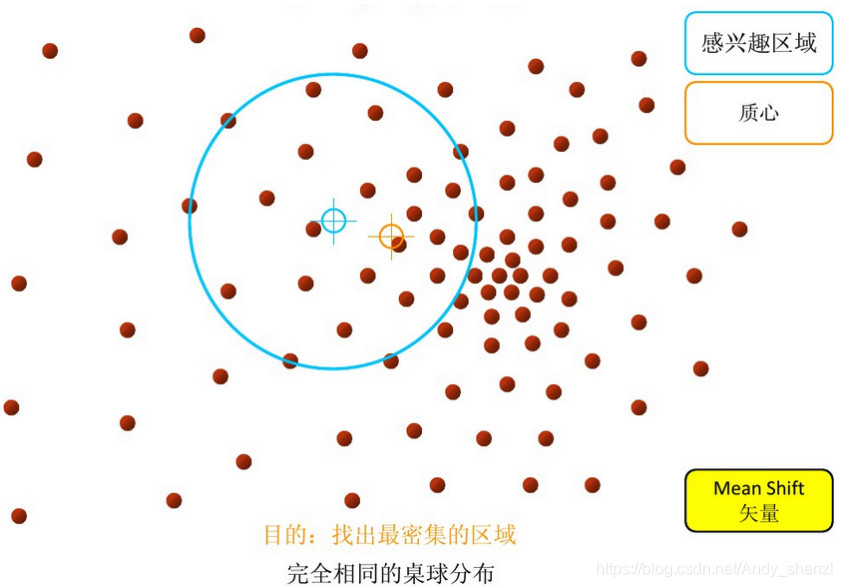目录
Mean shift 算法是基于核密度估计的爬山算法,可用于聚类、图像分割、跟踪等,因为最近搞一个项目,涉及到这个算法的图像聚类实现,因此这里做下笔记。
mean shift 算法理论
Mean-shift(即:均值迁移)的基本思想:在数据集中选定一个点,然后以这个点为圆心,r为半径,画一个圆(二维下是圆),求出这个点到所有点的向量的平均值,而圆心与向量均值的和为新的圆心,然后迭代此过程,直到满足一点的条件结束。(Fukunage在1975年提出)
Mean-Shift是一种基于滑动窗口的聚类算法。也可以说它是一种基于质心的算法,这意思是它是通过计算滑动窗口中的均值来更新中心点的候选框,以此达到找到每个簇中心点的目的。然后在剩下的处理阶段中,对这些候选窗口进行滤波以消除近似或重复的窗口,找到最终的中心点及其对应的簇。
整体的图例如下:

分步骤演示:
步骤1:在指定的区域内计算偏移均值(如下图的黄色的圈)

步骤2:移动该点到偏移均值点处

步骤3: 重复上述的过程(计算新的偏移均值,移动)





我们再用一个比较直观的实例看一下:




基本的Mean Shift向量形式

sklearn参数
[class sklearn.cluster.MeanShift]
bandwidth=None: float,高斯核函数的半径(或带宽),如果没有给定,则使用sklearn.cluster.estimate_bandwidth 自动估计带宽;
seeds=None: array, shape=[n_samples, n_features],我理解的 seeds 是初始化的质心,如果为 None 并且 bin_seeding=True,就用 clustering.get_bin_seeds 计算得到;
bin_seeding=False: boolean,在没有设置 seeds 时起作用,如果 bin_seeding=True,就用 clustering.get_bin_seeds 计算得到质心,如果 bin_seeding=False,则设置所有点为质心;
min_bin_freq=1: int,clustering.get_bin_seeds 的参数,设置的最少质心个数;
以上三个参数要结合起来理解;
cluster_all=True: boolean,如果为 True,所有的点都会被聚类,包括不在任何核内的孤立点,其会选择一个离自己最近的核;如果为 False,孤立点的类标签为 -1;
n_jobs=1: int,多线程;
-1:使用所有的cpu;
1:不使用多线程;
-2:如果 n_jobs<0,(n_cpus + 1 + n_jobs)个cpu被使用,所以 n_jobs=-2 时,所有的cpu中只有一块不被使用;
主要属性
cluster_centers_ : 数组类型。计算出的聚类中心的坐标。
labels_ :数组类型。每个数据点的分类标签。
python—sklearn实例演示
我们运用K-means里面的一个数据样本:
import numpy as np
cluster1 = np.random.uniform(0.5, 1.5, (2, 10))
cluster2 = np.random.uniform(3.5, 4.5, (2, 10))
X = np.hstack((cluster1, cluster2)).T#合并数据
plt.figure()
plt.axis([0, 5, 0, 5])
plt.grid(True)
plt.plot(X[:,0],X[:,1],'k.')
导入相关包
from sklearn.cluster import MeanShift, estimate_bandwidthbandwidth1 = estimate_bandwidth(X, quantile=0.2)ms = MeanShift(bandwidth=bandwidth, bin_seeding=True)
ms.fit(X)
labels = ms.labels_
cluster_centers = ms.cluster_centers_
labels_unique = np.unique(labels)
n_clusters_ = len(labels_unique)
print("number of estimated clusters : %d" % n_clusters_)number of estimated clusters : 2
import matplotlib.pyplot as plt
from itertools import cycle
plt.figure(1)
plt.clf()
colors = cycle('bgrcmykbgrcmykbgrcmykbgrcmyk')
for k, col in zip(range(n_clusters_), colors):
my_members = labels == k
cluster_center = cluster_centers[k]
plt.plot(X[my_members, 0], X[my_members, 1], col + '.')
plt.plot(cluster_center[0], cluster_center[1], 'o', markerfacecolor=col,
markeredgecolor='k', markersize=14)
plt.title('Estimated number of clusters: %d' % n_clusters_)
plt.show()
PS:
bandwidth=None: float,高斯核函数的半径(或带宽),如果没有给定,则使用sklearn.cluster.estimate_bandwidth 自动估计带宽
我们上面就是运用了sklearn.cluster.estimate_bandwidth计算了bandwidth
对于bandwidth我们简单解释下
estimate_bandwidth(X, quantile=0.3, n_samples=None, random_state=0, n_jobs=None)
X : array-like, shape=[n_samples, n_features]
Input points.
quantile : float, default 0.3
should be between [0, 1] 0.5 means that the median of all pairwise distances is used.
n_samples : int, optional
The number of samples to use. If not given, all samples are used.
random_state : int, RandomState instance or None (default)
The generator used to randomly select the samples from input points for bandwidth estimation. Use an int to make the randomness deterministic. See Glossary.
n_jobs : int or None, optional (default=None)
The number of parallel jobs to run for neighbors search.
Nonemeans 1 unless in ajoblib.parallel_backendcontext.-1means using all processors. See Glossary for more details.
举个例子对quantile的影响来看一下:
import numpy as np
X0 = np.array([7, 5, 7, 3, 4, 1, 0, 2, 8, 6, 5, 3])
X1 = np.array([5, 7, 7, 3, 6, 4, 0, 2, 7, 8, 5, 7])
X00=np.array(list(zip(X0, X1))).reshape(len(X0), 2)#组合数据
import matplotlib.pyplot as plt
plt.figure()
plt.scatter(X00[:, 0], X00[:, 1],c='b')#原始数据散点图
from sklearn.cluster import MeanShift, estimate_bandwidth
for a in list(range(2,10,1)):
b=a/10
bandwidth = estimate_bandwidth(X00, quantile=b)
ms = MeanShift(bandwidth=bandwidth, bin_seeding=True)
ms.fit(X00)
labels = ms.labels_
cluster_centers = ms.cluster_centers_
labels_unique = np.unique(labels)
n_clusters_ = len(labels_unique)
print("number of estimated clusters : %d" % n_clusters_)number of estimated clusters : 5 number of estimated clusters : 5 number of estimated clusters : 3 number of estimated clusters : 2 number of estimated clusters : 2 number of estimated clusters : 1 number of estimated clusters : 1 number of estimated clusters : 1
我们可以看到随着 quantile的增大,聚类的数量随之减少。
for a in list(range(2,10,1)):
b=a/10
bandwidth = estimate_bandwidth(X00, quantile=b)
ms = MeanShift(bandwidth=bandwidth, bin_seeding=True)
ms.fit(X00)
labels = ms.labels_
cluster_centers = ms.cluster_centers_
labels_unique = np.unique(labels)
n_clusters_ = len(labels_unique)
plt.figure(figsize=(16, 16))
colors = cycle('bgrcmykbgrcmykbgrcmykbgrcmyk')
for k, col in zip(range(n_clusters_), colors):
my_members = labels == k
cluster_center = cluster_centers[k]
plt.plot(X00[my_members, 0], X00[my_members, 1], col + '.')
plt.plot(cluster_center[0], cluster_center[1], 'o', markerfacecolor=col,
markeredgecolor='k', markersize=14)
plt.title('Estimated number of clusters: %d' % n_clusters_)
plt.show()
plt.savefig('test1')
